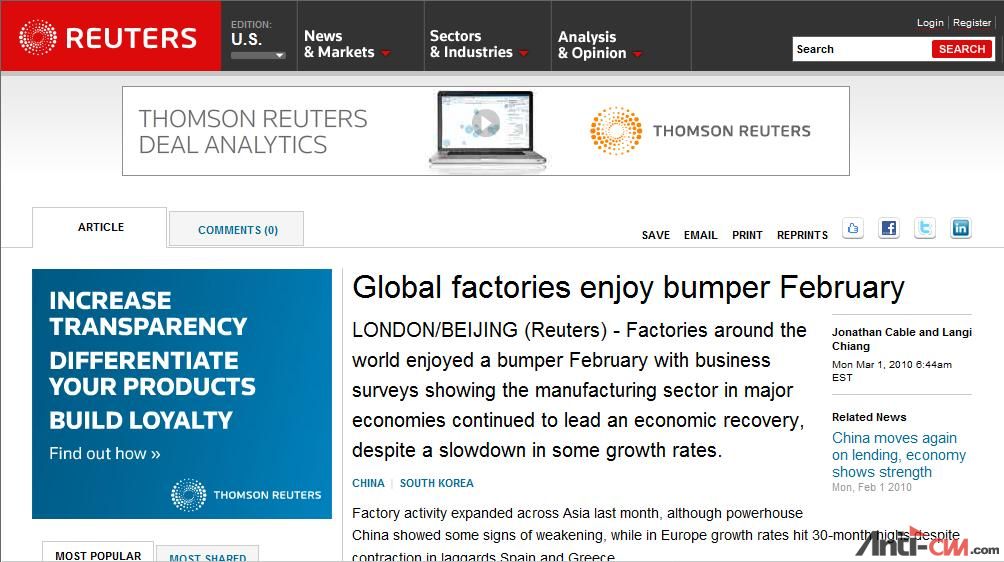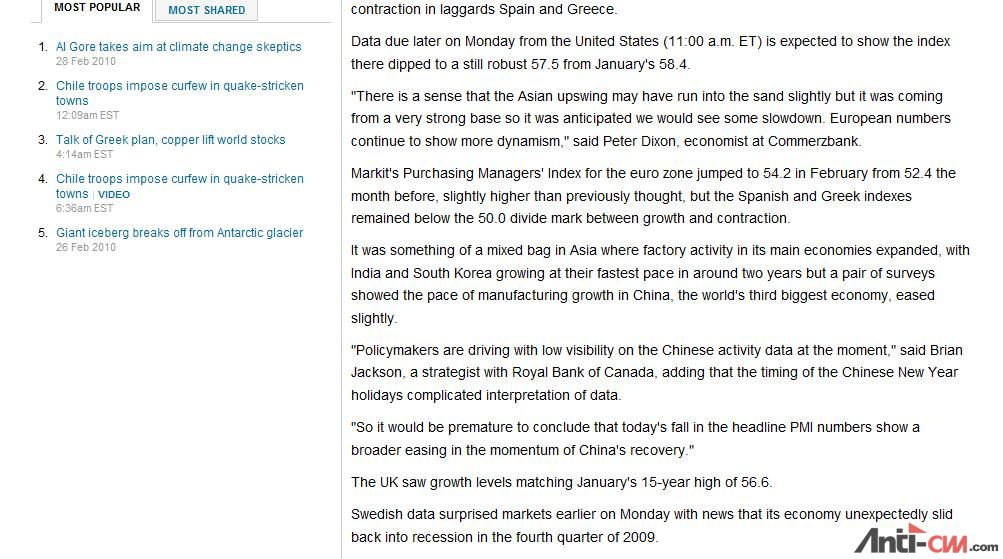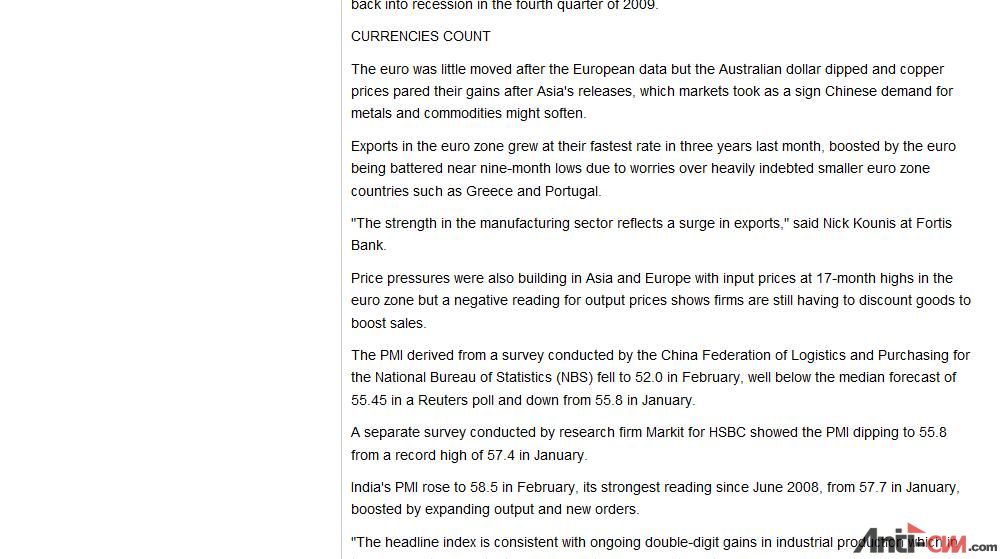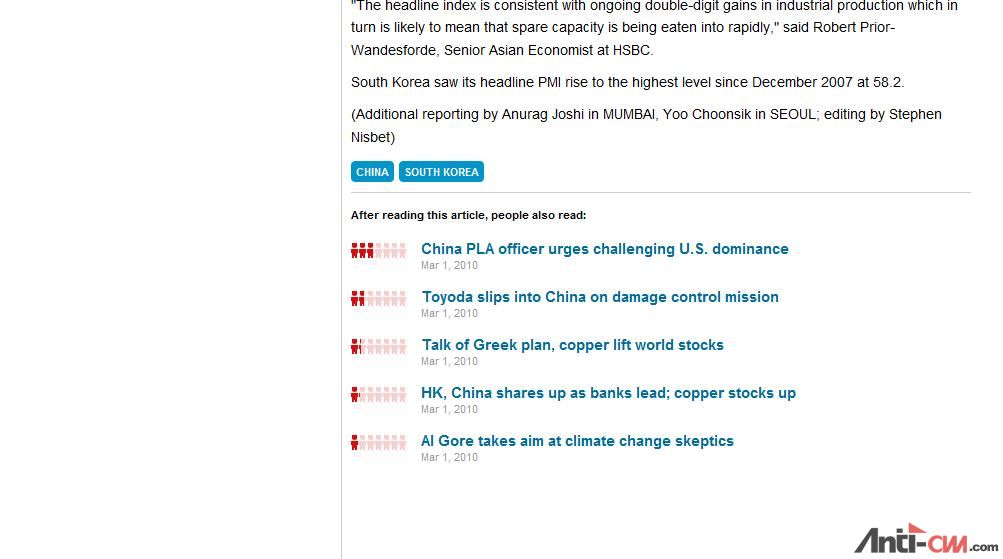|
|
【原文标题】Global factories enjoy bumper February
【原文链接】http://www.reuters.com/article/idUSTRE62011D20100301?loomia_ow=t0:s0:a49:g43:r5:c0.041591:b31204042:z0
【时间或作者】2010.3.1
【正文】
LONDON/BEIJING (Reuters) - Factories around the world enjoyed a bumper February with business surveys showing the manufacturing sector in major economies continued to lead an economic recovery, despite a slowdown in some growth rates.
China | South Korea
Factory activity expanded across Asia last month, although powerhouse China showed some signs of weakening, while in Europe growth rates hit 30-month highs despite contraction in laggards Spain and Greece.
Data due later on Monday from the United States (11:00 a.m. ET) is expected to show the index there dipped to a still robust 57.5 from January's 58.4.
"There is a sense that the Asian upswing may have run into the sand slightly but it was coming from a very strong base so it was anticipated we would see some slowdown. European numbers continue to show more dynamism," said Peter Dixon, economist at Commerzbank.
Markit's Purchasing Managers' Index for the euro zone jumped to 54.2 in February from 52.4 the month before, slightly higher than previously thought, but the Spanish and Greek indexes remained below the 50.0 divide mark between growth and contraction.
It was something of a mixed bag in Asia where factory activity in its main economies expanded, with India and South Korea growing at their fastest pace in around two years but a pair of surveys showed the pace of manufacturing growth in China, the world's third biggest economy, eased slightly.
"Policymakers are driving with low visibility on the Chinese activity data at the moment," said Brian Jackson, a strategist with Royal Bank of Canada, adding that the timing of the Chinese New Year holidays complicated interpretation of data.
"So it would be premature to conclude that today's fall in the headline PMI numbers show a broader easing in the momentum of China's recovery."
The UK saw growth levels matching January's 15-year high of 56.6.
Swedish data surprised markets earlier on Monday with news that its economy unexpectedly slid back into recession in the fourth quarter of 2009.
CURRENCIES COUNT
The euro was little moved after the European data but the Australian dollar dipped and copper prices pared their gains after Asia's releases, which markets took as a sign Chinese demand for metals and commodities might soften.
Exports in the euro zone grew at their fastest rate in three years last month, boosted by the euro being battered near nine-month lows due to worries over heavily indebted smaller euro zone countries such as Greece and Portugal.
"The strength in the manufacturing sector reflects a surge in exports," said Nick Kounis at Fortis Bank.
Price pressures were also building in Asia and Europe with input prices at 17-month highs in the euro zone but a negative reading for output prices shows firms are still having to discount goods to boost sales.
The PMI derived from a survey conducted by the China Federation of Logistics and Purchasing for the National Bureau of Statistics (NBS) fell to 52.0 in February, well below the median forecast of 55.45 in a Reuters poll and down from 55.8 in January.
A separate survey conducted by research firm Markit for HSBC showed the PMI dipping to 55.8 from a record high of 57.4 in January.
India's PMI rose to 58.5 in February, its strongest reading since June 2008, from 57.7 in January, boosted by expanding output and new orders.
"The headline index is consistent with ongoing double-digit gains in industrial production which in turn is likely to mean that spare capacity is being eaten into rapidly," said Robert Prior-Wandesforde, Senior Asian Economist at HSBC.
South Korea saw its headline PMI rise to the highest level since December 2007 at 58.2.
(Additional reporting by Anurag Joshi in MUMBAI, Yoo Choonsik in SEOUL; editing by Stephen Nisbet)
【全文截图】




|
bumper, enjoy, February, global, reuters, bumper, enjoy, February, global, reuters, bumper, enjoy, February, global, reuters
评分
-
1
查看全部评分
-
|